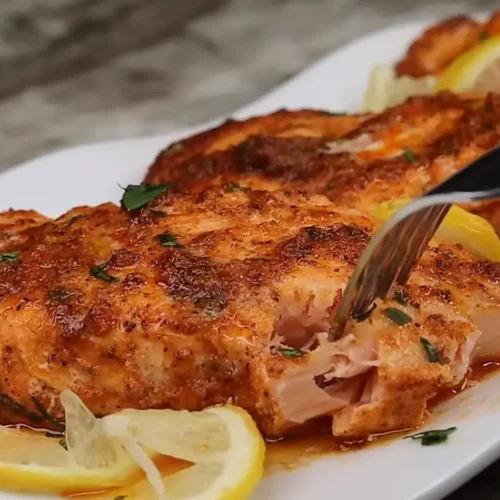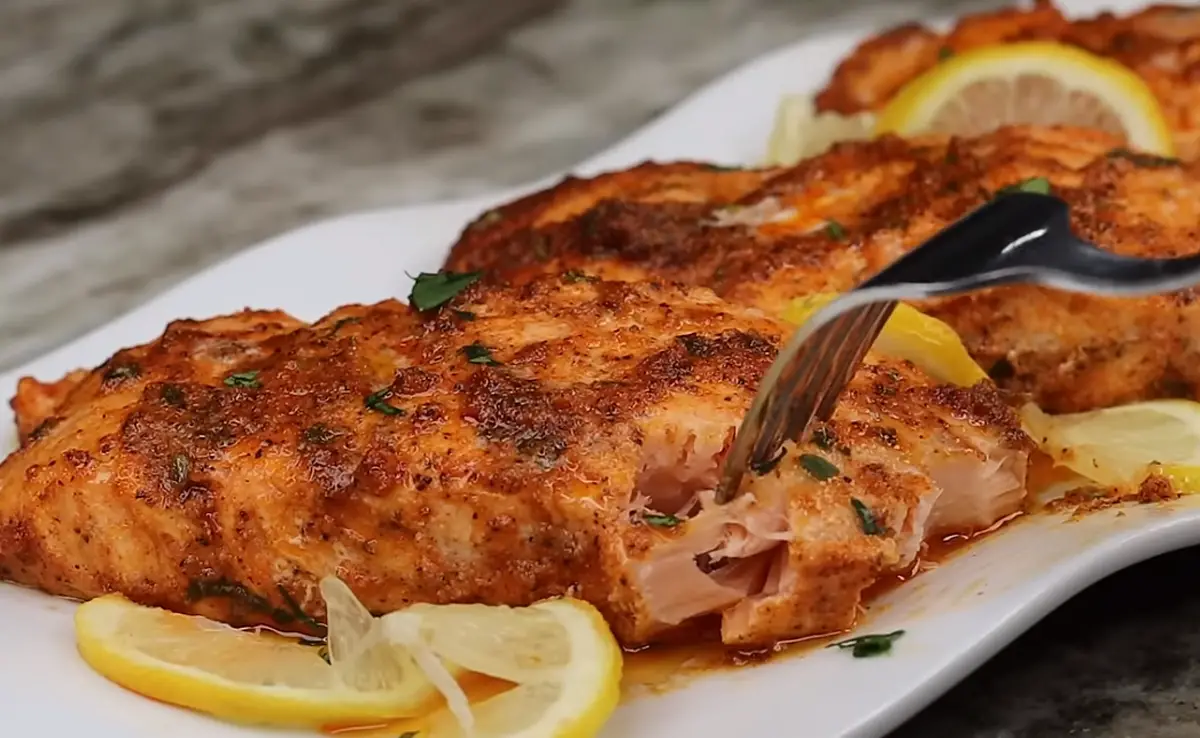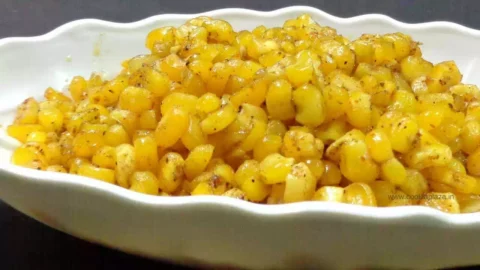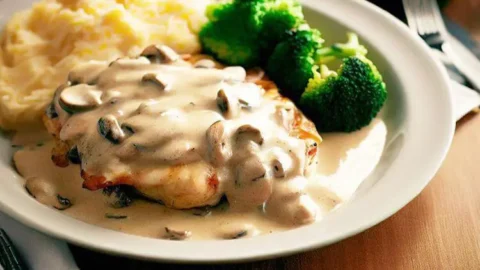Hey there! If you’ve ever craved that mouthwatering Texas Roadhouse salmon and thought, “I wish I could make this at home,” then you, my friend, are in for a treat. I’m here to guide you through a flavor-packed journey to create the yummiest Texas Roadhouse salmon recipe right in your kitchen. So, grab your apron, and let’s get cooking!
Table of Contents
ToggleTexas Roadhouse Salmon Recipe Overview
- Course: Main Dish
- Cuisine: American
- Total Servings: 4
- Prep Time: 15 minutes
- Cook Time: 15 minutes
- Total Time: 30 minutes
Equipment Needed
When we talk about making this delectable salmon, there’s no need for fancy gadgets. You’ll feel like a pro with these simple tools. Here’s what you need to bring the taste of Texas Roadhouse salmon to your dining table:
- A skillet or grill pan
- Mixing bowls
- Measuring cups and spoons
- A whisk or fork for mixing
Trust me, with the right equipment, making this Texas Roadhouse salmon recipe becomes as easy as pie.
Ingredients for Texas Roadhouse Salmon Recipe
Here’s what you’ll need to make your salmon unforgettable:
| Ingredient | Quantity |
|---|---|
| Salmon fillets | 4 (6-oz each) |
| Olive oil | 2 tablespoons |
| Brown sugar | 3 tablespoons |
| Soy sauce | 2 tablespoons |
| Garlic, minced | 2 cloves |
| Lemon juice | 1 tablespoon |
| Ground black pepper | 1 teaspoon |
| Dried oregano | 1/2 teaspoon |
| Paprika | 1/2 teaspoon |
Fact: Did you know that salmon is not just tasty but also incredibly nutritious? It’s a fantastic source of omega-3 fatty acids, which are great for your heart!
Step by Step Instructions
Preparing the Marinade
- In a bowl, combine olive oil, brown sugar, soy sauce, minced garlic, lemon juice, black pepper, dried oregano, and paprika.
- Whisk everything together until the sugar is mostly dissolved.
A good marinade is like a secret sauce, it can transform your dish from good to great!
Marinating the Salmon
- Place the salmon fillets in a dish or a large ziplock bag.
- Pour the marinade over the salmon, making sure each piece is well-coated.
- Let it marinate in the fridge for at least 30 minutes, or for the best flavor, overnight.
Patience is a virtue, especially when it comes to marinating.
Cooking the Salmon
- A grill pan or skillet should be heated over medium-high heat. Lightly brush it with oil to inhibit adhering.
- Skin-side down, put the salmon fillets in the pan. Cook for about 4-6 minutes on each side, or until the salmon flakes easily with a fork.
- While cooking, baste the fillets with the remaining marinade for extra flavor.
The secret to perfectly cooked salmon is not to overdo it. Keep an eye on the texture.
Serving the Salmon
- Just take the salmon off the heat when it’s done.
- Serve hot with your choice of sides. A fresh salad or steamed veggies make a great pair.
The moment of truth – that first bite will tell you everything you need to know about your cooking skills.
Additional Tips for Perfect Texas Roadhouse Salmon
- Skin on or off? Keeping the skin on while cooking helps retain the salmon’s moisture. Plus, it gets wonderfully crispy.
- Leftover marinade? Bring it to a boil for a few minutes and use it as a sauce to drizzle over the cooked salmon.
- Flavor boost: For an extra flavor kick, add a pinch of red pepper flakes to your marinade.
Nutrition in Texas Roadhouse Salmon Recipe
| Nutrient | Amount per serving |
|---|---|
| Calories | 345 kcal |
| Protein | 34g |
| Fat | 19g |
| Carbohydrates | 9g |
| Omega-3 Fatty Acids | High |
Please note, these are approximate values. Actual nutritional content may vary based on ingredient choices and portion sizes.
What Makes Texas Roadhouse Salmon Recipe Delicious
There’s something about this Texas Roadhouse salmon recipe that just hits the spot every time. Maybe it’s the perfect blend of sweetness and tanginess from the marinade, or perhaps it’s the way the salmon cooks up so tender and flaky.
Fact: The right marinade can elevate your salmon from simple to spectacular. It’s all about finding that balance of flavors!
This recipe captures the essence of what makes salmon not just a meal, but an experience. The key lies in the marinade – it’s not just about the ingredients but how they come together to create a harmony of flavors that complements the rich, buttery taste of salmon.
FAQs about Texas Roadhouse Salmon Recipe
How can I make sure my salmon doesn’t stick to the pan?
A good trick is to ensure your pan is nice and hot before adding the salmon. Also, brushing the pan with a bit of oil can create a non-stick surface. Remember, once you place your salmon in the pan, give it time to form a crust before flipping it over.
Can I use frozen salmon for this recipe?
Absolutely! Make sure to let it thaw all the way in the fridge before you use it. This way, you’ll get the best texture and flavor once it’s cooked.
What are the best sides to serve with Texas Roadhouse salmon?
Light sides like sautéed veggies, a quinoa salad, or roasted potatoes complement the flavors of the salmon beautifully. If you’re feeling adventurous, try a citrusy fruit salsa on the side.
Can I grill the salmon instead of pan-searing?
Yes, grilling is a fantastic way to prepare salmon. It adds a smoky flavor that’s hard to beat. Just make sure your grill is clean and oiled before cooking to prevent sticking.
How do I know when my salmon is cooked perfectly?
The best indicator is the texture. Once the salmon easily flakes with a fork and has a slight translucency in the center, it’s done. Overcooking can dry it out, so keep a close eye on it.
Conclusion
Creating the Texas Roadhouse salmon recipe at home is more than just cooking; it’s an adventure in flavors that promises to deliver a restaurant-quality dish right to your table. With simple ingredients and easy-to-follow steps, you can impress your family or guests any day of the week.
Therefore, put on your chef’s hat and start this culinary journey. Trust me, the delicious outcome is well worth the effort. And hey, I’d love to hear how your Texas Roadhouse salmon turns out! Feel free to leave comments, questions, or any feedback you might have. Let’s keep the conversation going and share the joy of cooking together. Happy cooking!
Check out some more delicious main course recipes:
- Cry Baby Noodles Recipe: A Guide to Spice up Your Meals
- Mike’s Farm Mac and Cheese Recipe
- Champions Peabody Steak Tip Recipe
- Publix Caesar Pasta Salad Recipe
- Crab Shala Recipe: A Culinary Delight to Savor
- Texas Roadhouse Smothered Chicken Recipe

Texas Roadhouse Salmon Recipe
Equipment
- A skillet or grill pan
- Mixing bowls
- Measuring cups and spoons
- A whisk or fork for mixing
Ingredients
- 4 6-oz each Salmon fillets
- 2 tablespoons Olive oil
- 3 tablespoons Brown sugar
- 2 tablespoons Soy sauce
- 2 cloves Garlic minced
- 1 tablespoon Lemon juice
- 1 teaspoon Ground black pepper
- 1/2 teaspoon Dried oregano
- 1/2 teaspoon Paprika
Instructions
Preparing the Marinade
- In a bowl, combine olive oil, brown sugar, soy sauce, minced garlic, lemon juice, black pepper, dried oregano, and paprika.
- Whisk everything together until the sugar is mostly dissolved.
Marinating the Salmon
- Place the salmon fillets in a dish or a large ziplock bag.
- Pour the marinade over the salmon, making sure each piece is well-coated.
- Let it marinate in the fridge for at least 30 minutes, or for the best flavor, overnight.
Cooking the Salmon
- A grill pan or skillet should be heated over medium-high heat. Lightly brush it with oil to inhibit adhering.
- Skin-side down, put the salmon fillets in the pan. Cook for about 4-6 minutes on each side, or until the salmon flakes easily with a fork.
- While cooking, baste the fillets with the remaining marinade for extra flavor.
Serving the Salmon
- Just take the salmon off the heat when it’s done.
- Serve hot with your choice of sides. A fresh salad or steamed veggies make a great pair.
Notes
- Skin on or off? Keeping the skin on while cooking helps retain the salmon’s moisture. Plus, it gets wonderfully crispy.
- Leftover marinade? Bring it to a boil for a few minutes and use it as a sauce to drizzle over the cooked salmon.
- Flavor boost: For an extra flavor kick, add a pinch of red pepper flakes to your marinade.





